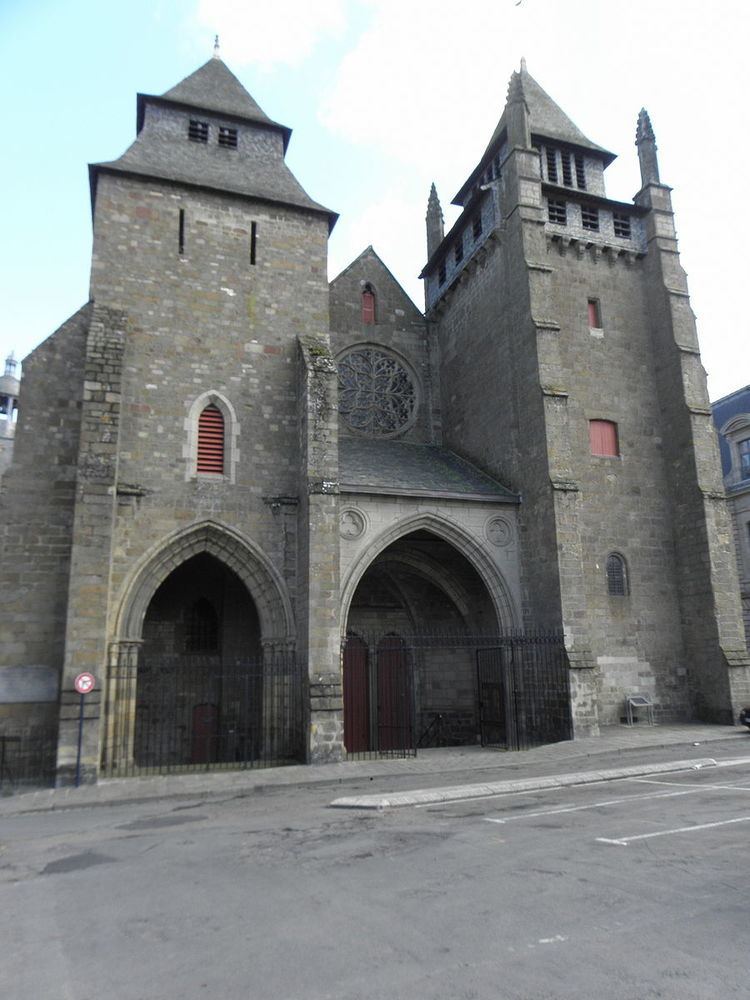Ecclesiastical province Rennes Denomination Roman Catholic Area 6,867 km² | Parishes 58 Phone +33 2 96 68 12 70 Bishop Denis Moutel | |
 | ||
Population- Total- Catholics (as of 2014)591,641582,000 (98.4%) Similar Presbytère, Presbytère Saint Michel, Église Saint Michel, Saint‑Brie Cathedral, Presbytère de la paroisse | ||
The Roman Catholic Diocese of Saint-Brieuc and Tréguier (Latin: Dioecesis Briocensis et Trecorensis; French: Diocèse de Saint-Brieuc et Tréguier) is a diocese of the Latin Rite of the Roman Catholic Church in France. The diocese comprises the department of Côtes d'Armor in the Region of Brittany. The diocese is currently suffragan to the Archdiocese of Rennes, Dol, and Saint-Malo. The current bishop is Denis Moutel, appointed in 2010.
Contents
Originally erected according to legend in the 5th century, the diocese was suppressed by the French Revolution. Re-established by the Concordat of 1802, the diocese became a suffragan to the Archdiocese of Tours. Later, in 1850, it became suffragan of the Archdiocese of Rennes. The Diocese of Saint-Brieuc was formed to include: (1) the ancient diocese of the same name; (2) the greater portion of the Diocese of Tréguier; (3) a part of the old Dioceses of St. Malo, Dol, and Quimper and Léon, and the (4) parishes of the Diocese of Vannes. In 1852 the Bishops of Saint-Brieuc were authorized to add to their title that of the ancient See of Tréguier.
History
A Welsh saint, Brioc(us) (Brieuc), who died at the beginning of the sixth century founded in honour of St. Stephen a monastery which afterwards bore his name, and from which sprang the town of Saint-Brieuc. Brieuc's life makes no mention of him being a bishop. An inscription later than the ninth century on his tomb, at Saint-Serge at Angers, where his alleged body was transported in the 850s, mentions him as the first Bishop of Saint-Brieuc. His alleged remains at Saint-Serge were moved to a different tomb in 1166, in the presence of King Henry II of England. His remains were carried back to Saint-Brieuc in 1210.
It was King Nomenoe who, about the middle of the ninth century, is said to have made the monastery the seat of a bishop. Barthélemy Hauréau, however, begins his series of bishops in Gallia christiana with Bishop Adam (ca. 1032).
Among the Bishops of Saint-Brieuc, the following are mentioned: St. Guillaume Pinchon (1220–34), who protected the rights of the episcopate against Pierre Mauclerc, Duke of Brittany, and was forced to go into exile for some time at Poitiers; Jean du Tillet (1553–64), later Bishop of Meaux; Denis de La Barde (1641–75); and Jean-Baptiste de Caffarelli du Falga (1802-15).
The principal pilgrimages in the Diocese of Saint-Brieuc are: Notre-Dame de Bon Secours at Guingamp, the sanctuary of which was enriched by the munificence of the Dukes of Brittany; Notre Dame d'Espérance, at Saint-Brieuc, a pilgrimage dating from 1848; Notre Dame de La Fontaine at Saint-Brieuc, dating from the establishment of an oratory by Saint-Brieuc, and revived in 1893 to encourage devotion to that Saint; Notre Dame de Guyaudet, near St-Nicholas du Pélem; and Notre Dame de LaRonce, at Rostrenen, a church raised to the status of a Collegiate Church by Sixtus IV in 1483.
At the end of the eighteenth century, on the eve of the French Revolution, the Cathedral had a Chapter composed of six Dignities: the Dean, the Treasurer, the Archdeacon of Penthièvre, the Archdeacon of Goëlo, the Scholastic, and the Cantor; there were twenty prebends. The first prebend always belonged to the Duc de Penthièvre. There were 113 parish churches, 13 chapels in small villages, 4 Collegiate Churches (one just outside the walls of Saint-Brieuc dedicated to Guillaume Pinchon, the martyr bishop) and four abbeys of male monks.
During the French revolution the Diocese of Saint-Brieuc was abolished and subsumed into a new diocese, coterminous with the new 'Departement des Côtes-du-Nord', and a suffragan of the 'Metropole du Nord-Ouest' at Rennes. The clergy were required to swear and oath to the Constitution, and under the terms of the Civil Constitution of the Clergy a new bishop was to be elected by all the voters of the departement. This placed them in schism with the Roman Catholic Church and the Pope. The electors chose Father Jean-Marie Jacob, the curé of Lannebert, as their new Constitutional Bishop. He was consecrated in Nôtre-Dame in Paris by Constitutional Bishop Gobel on 1 May 1791. Gobel, a legitimate bishop, consecrated in 1772, had apostasized and was then Constitutional Bishop of Paris. The legitimate Bishop Bellecize had fled his diocese, leaving its administration in the hands of his vicars-general. 1n 1795 and 1796 Bishop Jacob was part of the movement seeking an accommodation with Rome. He faced great difficulties both from the flight of many of his clergy in the face of the Terror, and from the seizure of large areas of the countryside by the Chouans, who were loyal to the monarchy. Jacob fell ill during a trip to Paris and died there on 28 May 1801. An election was being prepared to elect his successor, when First Consul Napoleon Bonaparte ordered all the Constitutional Bishops to resign. He was striking a Concordat with Pope Pius VII, which included the liquidation of the Constitutional Church.
